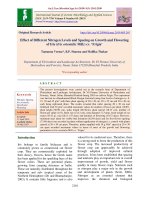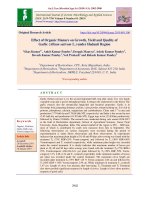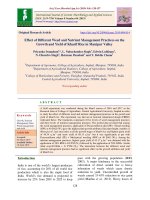Effect of spacing and fertility levels on yield and productivity of multi-cut forage sorghum [Sorghum bicolor (L.) Moench]
Bạn đang xem bản rút gọn của tài liệu. Xem và tải ngay bản đầy đủ của tài liệu tại đây (185.15 KB, 5 trang )
Int.J.Curr.Microbiol.App.Sci (2019) 8(3): 755-759
International Journal of Current Microbiology and Applied Sciences
ISSN: 2319-7706 Volume 8 Number 03 (2019)
Journal homepage:
Original Research Article
/>
Effect of Spacing and Fertility Levels on Yield and Productivity of
Multi-cut Forage Sorghum [Sorghum bicolor (L.) Moench]
Surja Ram, V. Nepalia, Ganga Ram Mali*, Manish Bera and Dileep Singh
Rajasthan College of Agriculture, Maharana Pratap University of Agriculture and
Technology, Udaipur – 313001 (Rajasthan), India
*Corresponding author
ABSTRACT
Keywords
Spacing and
Fertility Levels,
Sorghum
(Sorghum bicolor)
Article Info
Accepted:
07 February 2019
Available Online:
10 March 2019
A field experiment was conducted for Evaluation of Spacing and Fertility
Levels for Multi-Cut Forage Sorghum. It was found that maximum increase
in maximum increase in green and dry fodder yield was obtained with
spacing 30 cm x 10 cm (54.77 and 15.91 t/ha, respectively) with the highest
net returns ( 44881 /ha) and B-C ratio (1.41) and application of 125%
RDF proved most economically as it recorded highest net returns ( 46607
/ha) and B C ratio (1.42) compared to 75% RDF and 100% RDF.
cost of milk production accounting for 55-60
per cent of the total cost of milk production. It
is estimated that the world food requirement
by the year 2050 will be double that of 2010.
A significant part of this requirement will
emanate from the developing countries, on
account of increased human populations,
disposable incomes and urbanization. For
livestock products, about two-thirds of this
increased demand will need to be met by
improving the production efficiency of feed,
both forages and concentrate feeds. However,
in addition to shortage of feed, it is well
documented worldwide that imbalanced
nutrition is a major factor responsible for low
livestock productivity (Tonapi et al., 2011).
Introduction
India has very large population of livestock,
the productivity of milk and other livestock
product per animal is very low compared to
other many countries in the world. One of the
main reasons for the low productivity of our
livestock is malnutrition, under-nutrition or
both, beside the low genetic potential of the
animals. The adequate supply of nutritive
fodder and feed is a crucial factor impacting
the productivity and performance of the
animals. The country is highly deficient in
respect of availability of green fodder, dry
fodder and concentrates (Grover and Kumar,
2012). Feeding is the major component of
755
Int.J.Curr.Microbiol.App.Sci (2019) 8(3): 755-759
Globally, sorghum is cultivated on 41 million
hectares to produce 64.20 million tonnes, with
productivity hovering around 1.60 tonnes per
hectare. With exceptions in some regions, it is
mainly produced and consumed by poor
farmers. India contributes about 16% of the
world's sorghum production. It is the fifth
most important cereal crop in the country. It is
now recognized worldwide as a smart crop
capable of providing food, feed, fodder and
fuel especially under moderate inputs,
especially in water-deficit environments in the
low rainfall areas. It is grown as green forage
(multi-cut) crop in north-Indian plains where
irrigation is available and as single-cut forage
mainly in drier parts of Western India (Tonapi
et al., 2011). Sorghum plants contain an
alkaloid, which releases hydrocyanic, or
prussic acid, when hydrolyzed. This can be
toxic to livestock. During periods of drought
or other stresses, sorghum tends to
accumulate nitrates, which can be toxic to
livestock. If retarded crop growth is observed,
forage needs to be analyzed for excessive
nitrates before feeding (Pandey and Roy,
2011). Plant density is one of the important
factor determines growth, development and
yield. Plant density selection to allow for
expression of maximum yield is a
management practice that would make
sorghum production more economical (Zand
and Shakiba, 2013).
strength and height were influenced little by
varying row spacing (Schatz et al., 1990).
The agronomic traits like total tillers number,
total fresh forage, total forage dry matter, leaf
dry matter, stem dry matter and leaf-stem
ratio are significantly affected by altering
plant density of sorghum (Bahrani and
Deghani ghenateghestani, 2004). Keeping the
above facts in view, the present investigation
was undertaken to know the effect of fertility
and spacing on yield of forage sorghum.
Materials and Methods
A field experiment was conducted at
Instructional Farm, Rajasthan College of
Agriculture, MPUAT, Udaipur during Kharif,
2016 season with the objectives to select
suitable multi-cut forage sorghum spacing for
this zone, work out optimum fertility level for
test sorghum genotypes and to access the
economically viable treatment. Soil of the
experimental field was sandy clay loam in
texture and was medium in available nitrogen
(281.40 kg /ha), phosphorus (21.46 kg /ha)
and high in available potassium (315.45 kg
/ha). The experiment consisted of 27
treatment combinations comprising three
levels of fertility (75, 100 and 125% RDF)
and three spacing (30 cm x 10 cm, 30 cm x 15
cm and 45 cm x 15 cm) laid out in factorial
randomized block design with three
replications.
The plant population and plant spacing has
always been complex question for sorghum
(Wylie, 2008). Maintenance of optimum
planting
density
through
appropriate
geometry is always a big problem to the
farmers. Substandard plant density result in
high weeds infestation, poor radiation use
efficiency and low yield, while dense plant
population on the other hand cause lodging,
poor light penetration in the canopy, reduce
photosynthesis production due to shading of
lower leaves and drastically reduce the yield.
Agronomic traits such as plant maturity, stalk
Yield attributes i.e., green forage, dry fodder
yield and total fodder yield were recorded at
1st and 2nd time of harvest. THE economics
analysis of each treatment was done on the
basis of prevailing market rates of the inputs
used and outputs obtained under each
treatment. The crop was sown on 06 June
2016 and was harvested on 9 September and
20 October 2016 as 1st and 2nd cutting,
respectively.
756
Int.J.Curr.Microbiol.App.Sci (2019) 8(3): 755-759
total dry fodder yield (15.91 t/ha) was
obtained by closer spacing of 30 cm x 10 cm.
It was significantly reduced by 8.30 and15.02
per cent by following wider spacing of 30 cm
x 15 cm and 45 cm x 15 cm, respectively.
Results and Discussion
Effect of spacing
Green forage yield
The maximum green forage yield of multicut forage sorghum at 1st cutting was obtained
by close spacing of 30 cm x 10 cm (30.50
t/ha). It was significantly superior (10.75 and
21.51 per cent) over wider spacing of 30 cm x
15 cm and 45 cm x 15 cm, respectively. The
data explicated that increasing spacing was
associated with significant reduction of green
forage yield at 2nd cutting. The maximum
yield (24.27 t/ha) was obtained when the crop
was sown at closer spacing of 30 cm x 10 cm.
It was reduced by 8.24 and 14.96 per cent by
sowing the crop at wider spacing of 30 cm x
15 cm and 45 cm x 15 cm, respectively. In
tune with 1st and 2nd cutting data, the highest
total green forage yield (54.77 t/ha) of the
multi-cut forage sorghum crop was recorded
under closer spacing of 30 cm x 10 cm which
was significantly higher (9.96 and 19.75
percent) over wider spacing of 30 cm x 15 cm
and 45 cm x 15 cm, respectively (Table 1).
Effect of fertility levels
Green forage yield
An insight of data revealed that increasing
fertility levels from 75 % up to 125 % RDF
tended to increase the green forage yield of
the crop at 1st cutting. Increase in level from
75 to 100 % RDF and from 100 to 125 %
RDF gave 16.00 and 21.26 per cent forage
yield enhancement. An examination of data
revealed that fertility levels had significantly
effect on green fodder yield at 2nd cutting. The
crop under the influence of 125% RDF
produced the highest green forage yield at
(23.87 t/ha 2nd cutting, which was
significantly higher over 75 % and 100 %
RDF by 12.70 and 7.91 per cent, respectively.
The total green forage yield was significantly
influenced by fertility levels. The data
revealed that the total green forage production
was highest (56.66 t/ha) when soil was
enriched with 125 % RDF. It was
significantly superior (15.26 and 27.35 per
cent) over 100 % and 75 % RDF,
respectively.
Dry fodder yield
There was a gradual and significant reduction
in dry fodder yield at 1st cutting by increasing
the spacing of crop. The maximum dry fodder
yield (7.71 t/ha) was observed when the crop
was closely spaced at 30 cm x 10 cm.
Widening the spacing to 30 cm x 15 cm and
45 cm x 15 cm was associated with
significant reduction of 9.08 and 19.72 per
cent in dry fodder yield, respectively in
comparison to close spacing of 30 cm x 10
cm. The maximum dry fodder yield at 2nd
cutting (8.20 t/ha) was recorded by keeping a
spacing of 30 cm x 10 cm. It reduced
significantly (7.56 and 13.78 per cent) by
widening the spacing to 30 cm x 15 cm and
45 cm x 15 cm, respectively. The maximum
Dry fodder yield
The maximum dry fodder yield at first cutting
(6.02 t/ha) was observed by supplying 75 %
RDF for crop raising. It was lifted to 6.90 t/ha
by supplying 100 % RDF and to a maximum
of 8.25 t/ha by supplying 125 % RDF which
was significantly higher over preceding
levels. Though the minimum dry fodder yield
(7.24 t/ha) was recorded by supplying 75 %
RDF but it was at par with yield obtained
(7.53 t/ha) under 100 % RDF. The minimum
dry fodder yield (8.08 t/ha) was harvested by
757
Int.J.Curr.Microbiol.App.Sci (2019) 8(3): 755-759
supplying 125 % RDF which was
significantly higher over 100 and 75 % RDF.
The total dry fodder yield of multi-cut fodder
sorghum increased significantly by supplying
nutrients at an increasing rate over a range of
75 to 125 % RDF. The maximum yield (16.33
t/ha) was observed by applying 125 % RDF
for crop raising which was significantly
greater (13.17 and 23.15 per cent) over 100
and 75 % RDF, respectively. The positive
response of multi-cut sorghum crop to
balanced fertilization is in close agreement
with the findings of Singh et al., (2008),
Singh et al., (2010) and Singh et al., (2014).
Table.1 Effect of spacing and fertility levels on yield of sorghum
Treatment
Yield (t/ha)
Spacing (cm x cm)
30 × 10
30 × 15
45 × 15
S Em±
CD (P = 0.05)
Fertility levels
75% RDF
100% RDF*
125% RDF
S Em±
CD (P = 0.05)
1st
Cutting
Green
forage
2nd
Cutting
30.50
27.54
25.10
0.77
2.31
23.31
27.04
32.79
0.77
2.31
Dry fodder
Total
1st
Cutting
2nd
Cutting
Total
24.27
22.27
20.64
0.57
1.70
54.77
49.81
45.74
1.18
3.53
7.71
7.01
6.44
0.18
0.54
8.20
7.58
7.07
0.18
0.53
15.91
14.59
13.52
0.31
0.94
21.18
22.12
23.87
0.57
1.70
44.49
49.16
56.66
1.18
3.53
6.02
6.90
8.25
0.18
0.54
7.24
7.53
8.08
0.18
0.53
13.26
14.43
16.33
0.31
0.94
* 90 kg N+40 kg P2O5+40 kg K2O /ha
Table.2 Effect of spacing and fertility levels on net return and BC ratio of sorghum
Treatments
Spacing (cm x cm)
30 × 10
30 × 15
45 × 15
S Em±
CD (P = 0.05)
Fertility levels
75% RDF
100% RDF*
125% RDF
S Em±
CD (P = 0.05)
Net return ( /ha)
B C ratio
44881
37941
32541
1650
4947
1.41
1.19
1.03
0.05
0.16
31621
37135
46607
1650
4947
1.03
1.17
1.42
0.05
0.16
* 90 kg N+40 kg P2O5+40 kg K2O /ha
758
Int.J.Curr.Microbiol.App.Sci (2019) 8(3): 755-759
yield and HCH content in fodder
sorghum [Sorghum bicolor (L.)
Moench]
varieties.
Range
Management and Agroforestry Issue
(A):52-58.
Singh, P., Sumeriya, H.K. and Meena, A.K.
2014. Response of sorghum [Sorghum
bicolor (L.) Moench] single cut forage
genotypes to nitrogen levels. Annals of
Agri-Bio Research. 19: 55-60.
Singh, P., Sumeriya, H.K., Sharma, V. and
Chhipa, K.G. 2008. Study on effect of
integrated nutrient management on
promising
sorghum
genotypes
SU1080. International Journal of
Tropical Agriculture. 26: 409-411.
Tonapi, V.A., Patil, J.V., Rao, B.D.,
Elangovan, M.B., Bhat, V. and
Raghavendra Rao, K.V. 2011.
Sorghum: Vision 2030. Directorate of
Sorghum Research, Rajendra Nagar,
Hyderabad, Andhra Pradesh 500 030,
India.
Wylie, P. 2008. Managing sorghum for high
yields:A blueprint for doubling
sorghum production. Grains Research
and
Development
Corporation.
Kingston ACT 2604.
Zand, N. and Shakiba, M.R. 2013. Effect of
plant density and fertilizer on some
attribute of grain sorghum [Sorghum
bicolor (L.) Moench]. International
Journal of Advanced Biological and
Biomedical Research. 1: 1577-1582.
Economics
The data (Table 2) revealed that multi-cut
sorghum spacing 30 cm x10 cm and 125 %
RDF fetched the highest net return and B C
ratio of
44881 /ha, 1.41 and
46607
/ha,1.42 respectively.
References
Bahrani, M.J., Deghani and Ghenateghestan,
A. 2004. Summer forage sorghum
yield, protein and prussic acid content
as affected by plant density and
nitrogen top dressing. Journal of
Agricultural Science Technology. 6:
73-83-73.
Grover, D.K. and Kumar, S. 2012. AERC
Study No. 29 Economics of
production, processing and marketing
of fodder crops in India (consolidated
report). Agro-Economic Research
centre Department of Economic and
Sociology
Punjab
Agricultural
University, Ludhiana-India.
Pandey, K.C. and Roy, A.K. 2011.Forage
Crops Varieties. IGFRI Jhansi (India).
pp. 1.
Schatz, B.G., Schneiter, A.A. and Gardner,
J.E. 1990. Effect of plant density on
grain sorghum production in North
Dakota.
North
Dakota
Farm
Research. 47: 15-17.
Singh, H, Choudhary, M and Singh, P. 2010.
Influence of fertility levels on fodder
How to cite this article:
Surja Ram, V. Nepalia, Ganga Ram Mali, Manish Bera and Dileep Singh. 2019. Effect of
Spacing and Fertility Levels on Yield and Productivity of Multi-cut Forage Sorghum [Sorghum
bicolor (L.) Moench]”. Int.J.Curr.Microbiol.App.Sci. 8(03): 755-759.
doi: />
759



![Mapping of quantitative trait loci (QTLS) associated with sugarcane aphids resistance in recombinant inbreed population of sorghum [Sorghum bicolor (L.) Moench]](https://media.store123doc.com/images/document/2020_01/09/medium_jrk1578566578.jpg)
![Development of an in vitro regeneration system in Sorghum [Sorghum bicolor (L.) Moench] using root transverse thin cell layers (tTCLs)](https://media.store123doc.com/images/document/2020_01/09/medium_nfv1578574721.jpg)
![Combining ability studies in forage sorghum [Sorghum bicolour (L.) Moench] for yield and quality parameters](https://media.store123doc.com/images/document/2020_01/09/medium_uoj1578577680.jpg)



